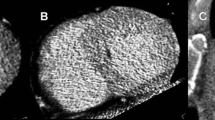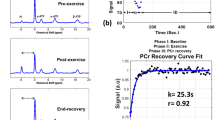Abstract
Purpose
The clinical differentiation between athlete’s heart and mild forms of non-obstructive hypertrophic cardiomyopathy (HCM) is crucial. We hypothesized that differences do exist between the myocardial metabolism of patients with non-obstructive HCM and competitive athletes (CAs). Our aim was to evaluate myocardial metabolism with 31P-MRS and 1H-MRS in HCM patients and CAs.
Materials and methods
After Ethics Committee approval, 15 CAs and 7 HCM patients were prospectively enrolled. They underwent a 1.5-T cardiac MR including electrocardiographically triggered cine images, single-voxel 1H-MRS and multivoxel 31P-MRS. 1H-MRS was performed after imaging using standard coil with the patient in the supine position; thereafter, 31P-MRS was performed using a dedicated coil, in the prone position. Data were reported as median and interquartile range. Mann–Whitney U test was used.
Results
In CAs, left ventricular mass index was 72 (66–83) g/m2, septal thickness 10 (10–11) mm, end diastolic volume index 95 (85–102) ml/m2, end systolic volume index 30 (28–32) ml/m2 and ejection fraction 68% (65–69%); in HCM patients, 81 (76–111) g/m2 (P = 0.052), 18 (15–21) mm (P = 0.003), 73 (58–76) ml/m2 (P = 0.029), 20 (16–34) ml/m2 (P = 0.274) and 68% (55–73%) (P = 1.000), respectively. At 1H-MRS, total lipids were 35 (0–183) arbitrary units (au) for CA and 763 (155–1994) au for HCM patients (P = 0.046). At 31P-MRS, PCr/γATP was 5 (4–6) au for CA and 4 (2–5) au for HCM patients (P = 0.230). Examination time was 20 min for imaging only, 5 min for 1H-MRS and 15 min for 31P-MRS.
Conclusions
We observed a significant increase of myocardial lipids, but a preserved PCr/γATP ratio in the metabolism of HCM patients compared with competitive CAs.



Similar content being viewed by others
References
Charron P, Carrier L, Dubourg O et al (1997) Penetrance of familial hypertrophic cardiomyopathy. Genet Couns 8:107–114
Maron BJ, Gardin JM, Flack JM et al (1995) Prevalence of hypertrophic cardiomyopathy in a general population of young adults. Echocardiographic analysis of 4111 subjects in the CARDIA Study. Coronary Artery Risk Development in (Young) Adults. Circulation 92:785–789
Crilley JG, Boehm EA, Blair E et al (2003) Hypertrophic cardiomyopathy due to sarcomeric gene mutations is characterized by impaired energy metabolism irrespective of the degree of hypertrophy. J Am Coll Cardiol 41:1776–1782
Van Driest SL, Ommen SR, Tajik AJ et al (2005) Sarcomeric genotyping in hypertrophic cardiomyopathy. Mayo Clin Proc 80:463–469. doi:10.1016/S0025-6196(11)63196-0
Wigle ED (2001) Cardiomyopathy: the diagnosis of hypertrophic cardiomyopathy. Heart 86:709–714
Lauschke J, Maisch B (2009) Athlete’s heart or hypertrophic cardiomyopathy? Clin Res Cardiol 98:80–88
Esposito A, De Cobelli F, Perseghin G et al (2009) Impaired left ventricular energy metabolism in patients with hypertrophic cardiomyopathy is related to the extension of fibrosis at delayed gadolinium-enhanced magnetic resonance imaging. Heart 95:228–233
Maron MS, Olivotto I, Zenovich AG et al (2006) Hypertrophic cardiomyopathy is predominantly a disease of left ventricular outflow tract obstruction. Circulation 114:2232–2239
Wight JN, Salem D (1995) Sudden cardiac death and the “athlete’s heart”. Arch Intern Med 155:1473–1480
Firoozi S, Sharma S, McKenna WJ (2003) Risk of competitive sport in young athletes with heart disease. Heart 89:710–714
Pelliccia A, Maron BJ, Spataro A et al (1991) The upper limit of physiologic cardiac hypertrophy in highly trained elite athletes. N Engl J Med 324:295–301
Maron BJ, Pelliccia A, Spirito P (1995) Cardiac disease in young trained athletes. Insights into methods for distinguishing athlete’s heart from structural heart disease, with particular emphasis on hypertrophic cardiomyopathy. Circulation 91:1596–1601
De Cobelli F, Esposito A, Belloni E et al (2009) Delayed-enhanced cardiac MRI for differentiation of Fabry’s disease from symmetric hypertrophic cardiomyopathy. AJR Am J Roentgenol 192:97–102
Sardanelli F, Quarenghi M (2006) MR spectroscopy of the heart. Radiol Med 111:1025–1034
Holloway CJ, Suttie J, Dass S, Neubauer S (2011) Clinical cardiac magnetic resonance spectroscopy. Prog Cardiovasc Dis 54:320–327. doi:10.1016/j.pcad.2011.08.002
Beyerbacht HP, Vliegen HW, Lamb HJ et al (1996) Phosphorus magnetic resonance spectroscopy of the human heart: current status and clinical implications. Eur Heart J 17:1158–1166
Lodi R, Rajagopalan B, Blamire AM et al (2004) Abnormal cardiac energetics in patients carrying the A3243G mtDNA mutation measured in vivo using phosphorus MR spectroscopy. Biochim Biophys Acta 1657:146–150
van Ewijk PA, Schrauwen-Hinderling VB, Bekkers SCAM et al (2015) MRS: a noninvasive window into cardiac metabolism. NMR Biomed 28:747–766. doi:10.1002/nbm.3320
Bottomley PA, Weiss RG (1998) Non-invasive magnetic-resonance detection of creatine depletion in non-viable infarcted myocardium. Lancet 351:714–718
Faller KME, Lygate CA, Neubauer S, Schneider JE (2013) 1H-MR spectroscopy for analysis of cardiac lipid and creatine metabolism. Heart Fail Rev 18:657–668
Nakae I, Mitsunami K, Omura T et al (2003) Proton magnetic resonance spectroscopy can detect creatine depletion associated with the progression of heart failure in cardiomyopathy. J Am Coll Cardiol 42:1587–1593
Ingwall JS (2009) Energy metabolism in heart failure and remodelling. Cardiovasc Res 81:412–419
Malavazos AE, Di Leo G, Secchi F et al (2010) Relation of echocardiographic epicardial fat thickness and myocardial fat. Am J Cardiol 105:1831–1835. doi:10.1016/j.amjcard.2010.01.368
van der Meer RW, Doornbos J, Kozerke S et al (2007) Metabolic imaging of myocardial triglyceride content: reproducibility of 1H MR spectroscopy with respiratory navigator gating in volunteers. Radiology 245:251–257. doi:10.1148/radiol.2451061904
Naressi A, Couturier C, Devos JM et al (2001) Java-based graphical user interface for the MRUI quantitation package. MAGMA 12:141–152
den Hollander JA, Evanochko WT, Pohost GM (1994) Observation of cardiac lipids in humans by localized 1H magnetic resonance spectroscopic imaging. Magn Reson Med 32:175–180
Felblinger J, Jung B, Slotboom J et al (1999) Methods and reproducibility of cardiac/respiratory double-triggered (1)H-MR spectroscopy of the human heart. Magn Reson Med 42:903–910
Hansch A, Rzanny R, Heyne J-P et al (2005) Noninvasive measurements of cardiac high-energy phosphate metabolites in dilated cardiomyopathy by using 31P spectroscopic chemical shift imaging. Eur Radiol 15:319–323
Jung WI, Sieverding L, Breuer J et al (1998) 31P NMR spectroscopy detects metabolic abnormalities in asymptomatic patients with hypertrophic cardiomyopathy. Circulation 97:2536–2542
Sardanelli F, Di Leo G (2009) Biostatistics for radiologists: planning, performing, and writing a radiologic study. Biostat Radiol Plan Perform Writ Radiol Study. doi:10.1007/978-88-470-1133-5
Sai E, Shimada K, Yokoyama T et al (2015) Evaluation of myocardial triglyceride accumulation assessed on 1H-magnetic resonance spectroscopy in apparently healthy Japanese subjects. Intern Med 54:367–373. doi:10.2169/internalmedicine.54.3024
Elliott P, McKenna WJ (2004) Hypertrophic cardiomyopathy. Lancet 363:1881–1891. doi:10.1016/S0140-6736(04)16358-7
Maron BJ, Maron MS (1997) Hypertrophic cardiomyopathy. Lancet 350:127–133. doi:10.1016/S0140-6736(12)60397-3
Nelson MD, Victor RG, Szczepaniak EW et al (2013) Cardiac steatosis and left ventricular hypertrophy in patients with generalized lipodystrophy as determined by magnetic resonance spectroscopy and imaging. Am J Cardiol 112:1019–1024. doi:10.1016/j.amjcard.2013.05.036
Utz W, Engeli S, Haufe S, Kast P, Hermsdorf M, Wiesner S, Pofahl M, Traber J, Luft FC, Boschmann M, Schulz-Menger J, Jordan J (2011) Myocardial steatosis, cardiac remodelling and fitness in insulin-sensitive and insulin-resistant obesewomen. Heart 97(19):1585–1589
Schrauwen-Hinderling VB, Meex RCR, Hesselink MKC et al (2011) Cardiac lipid content is unresponsive to a physical activity training intervention in type 2 diabetic patients, despite improved ejection fraction. Cardiovasc Diabetol 10:47. doi:10.1186/1475-2840-10-47
Jonker JT, de Mol P, de Vries ST et al (2013) Exercise and type 2 diabetes mellitus: changes in tissue-specific fat distribution and cardiac function. Radiology 269:434–442. doi:10.1148/radiol.13121631
Pluim BM, Lamb HJ, Kayser HW et al (1998) Functional and metabolic evaluation of the athlete’s heart by magnetic resonance imaging and dobutamine stress magnetic resonance spectroscopy. Circulation 97:666–672
Gutberlet M, Spors B, Grothoff M et al (2004) Comparison of different cardiac MRI sequences at 1.5 T/3.0 T with respect to signal-to-noise and contrast-to-noise ratios—initial experience. Rofo 176:801–808. doi:10.1055/s-2004-813220
Bottomley PA, Weiss RG (2001) Noninvasive localized MR quantification of creatine kinase metabolites in normal and infarcted canine myocardium. Radiology 219:411–418. doi:10.1148/radiology.219.2.r01ma39411
Sardanelli F, Fausto A, Di Leo G et al (2009) In vivo proton MR spectroscopy of the breast using the total choline peak integral as a marker of malignancy. Am J Roentgenol 192:1608–1617. doi:10.2214/AJR.07.3521
Acknowledgements
This research received no specific grants from any funding agency in the public, commercial or not-for-profit sectors.
Author information
Authors and Affiliations
Corresponding author
Ethics declarations
Conflict of interest
F Secchi and G. Di Leo have been sponsored to congresses by Bracco Imaging SpA (Milan, Italy). F. Sardanelli is on the speaker’s bureau for Bracco Imaging SpA (Milan, Italy) and received research grants from Bayer Healthcare (Berlin, Germany).
Ethical standards
This article does not contain any studies with human participants or animals performed by any of the authors.
Rights and permissions
About this article
Cite this article
Secchi, F., Di Leo, G., Petrini, M. et al. 1H- and 31P-myocardial magnetic resonance spectroscopy in non-obstructive hypertrophic cardiomyopathy patients and competitive athletes. Radiol med 122, 265–272 (2017). https://doi.org/10.1007/s11547-016-0718-2
Received:
Accepted:
Published:
Issue Date:
DOI: https://doi.org/10.1007/s11547-016-0718-2




